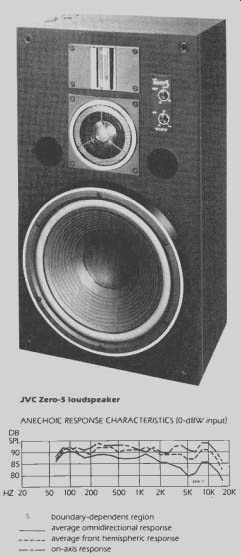JVC Updates the Ribbon Tweeter
JVC Zero-5 loudspeaker system in wood-veneer cabinet.
Dimensions: 14 1/2 by 26 inches (front), 13 1/2 inches deep.
Price: $400.
Warranty: "limited," five years parts and labor.
Manufacturer: Victor Co., Japan; U.S. distributor: JVC America, Inc. 58-75 Queens Midtown Expressway, Maspeth, N.Y. 11378.
------------

JVC Zero-5 loudspeaker
ANECHOIC RESPONSE CHARACTERISTICS (0-dBW input) boundary-dependent region average omnidirectional response average front hemispheric response on-axis response 5K AVERAGE OMNIDIRECTIONAL OUTPUT (250 Hz to 6 kHz) 86 1/4 dB SPL for 0 dBW 11 watt) input CONTINUOUS ON-AXIS OUTPUT (at 300 Hz) 113 SPL for 20 dBW 1100 watts) input 10K PULSED OUTPUT lat 300 Hz) 12 6 1/4 dB SPL for 33 1/4 dBW 12, 120 watts) peak "NOMINAL" IMPEDANCE 5.3 ohms
APPROX. TWEETER CONTROL RANGE (re "flat")
-6 dB above 8 kHz APPROX.
MIDRANGE CONTROL RANGE (re flat )
-6 d8, 800 Hz to 5.5 kHz

-----------
A body at rest is a formidable obstacle: The heavier it is (the greater its mass), the greater the force needed to overcome its inertia. For that reason, the fight to trim moving mass in loudspeaker drivers (as well as other physical transducers) has preoccupied audio designers for decades. Part of the appeal of ribbon tweeters has been their inherently low mass, and JVC's contribution is a refinement of that theme.
The classical ribbon tweeter is simply a thin conductor suspended in a strong magnetic field, demanding a transformer to keep the effective tweeter impedance high enough to load audio amplifiers properly. JVC came up with a hybrid in which an 8-ohm "voice coil" is photo-etched on the low-mass (48-milligram) diaphragm, raising the impedance and eliminating the matching transformer. Samarium cobalt magnets generate the required magnetic field. An aluminum horn/phase-equalizer helps improve the directivity of the resulting vibrations. JVC claims improved transient response characteristics, output up to 50 kHz, and high power-handling capability due to effective heat dissipation.
The Zero-5 is a three-way bass-reflex loudspeaker, with a 12-inch woofer and a 4-inch metal-dome midrange driver. Its construction mirrors the care lavished on speaker systems by Japanese manufacturers: A die-cast aluminum frame surrounds the woofer, a perforated aluminum cap protects the midrange driver, and the finish of the enclosure is truly luxurious. Screw posts on the back of the speaker connect it to the amplifier, and continuous-acting level controls for the midrange and tweeter are mounted on the baffle board.
In the tests at CBS Technology Center, the Zero-5 comes off very well in most important respects. The impedance curve, though a little quirky, is relatively well controlled, with the "nominal" rating of 5.3 ohms quite close to JVC's 6-ohm figure. Efficiency is fairly high, even for a vented system, but the speaker still took the full 20 dBW (100 watts) in the continuous-tone test with nary a sign of strain and didn't exceed distortion limits in the pulse test until peak input power had reached more than 33 dBW (2 kilowatts) and the sound pressure level was an ear-threatening 126 1/4 dB. The distortion measurements are, in fact, extremely low. In the moderate-power test (at 0 dBW, or 1 watt), both the second and the third harmonic remained below 1%-generally well below it-front at least 60 Hz up. At Ole higher level (100 dB SPL), the second harmonic increased somewhat but still without exceeding 1% over the same range, while the increase in the third harmonic was minuscule. Few loudspeakers we have measured have done as well.
The scope photos of the pulse tests, however, suggest some possible areas of complaint. At 300 Hz, the woofer is notably sluggish in responding to the head end of the pulse, with a slight overhang at the trailing end. At 3 kHz there is evidence of multiple, though very low-level reflections. The response data, too, present curiosities. The midrange and tweeter controls respond with unusual accuracy (vis-a-vis their marked calibration points from 0 to-6 dB with respect to "flat") and consistency, which bespeaks careful crossover design; but a response hole at the upper (5-kHz) crossover in the third-octave measurements shown in the graph disappears in swept-tone measurements, while another in the midrange (between 2 and 3 kHz) that appears with sweeps disappears in the third-octave tests. Since there often are significant differences between these measurements, we didn't pay much attention to them until we had conducted our listening tests, in which midrange coloration-a certain roughness and even honkiness, with a pinched sound on brasses and strings-was our panel's least laudatory but most consistent finding. We also found that stereo imaging was below average in stability and openness. This mediocre imaging, the measurement anomalies, and the perceived midrange roughness are related, we believe. Of less importance, in our opinion, is the response at both frequency extremes, where rolloff can be noted both in the graph and in the listening.
Among the most attractive properties our listeners perceived were unusually clean bass and treble (the respective rolloffs notwithstanding) and the excellent power-handling characteristics, and thus dynamic range, that the lab tests document. They also commented on a certain forwardness to the sound, which can be attractive in pop music particularly. But the Zero-5, attractive as it is in some respects, does not realize the full potential of the ribbon tweeter. Though we cannot confirm that the tweeter is capable of uncommonly flat response extending into the ultrasonic region, we liked what we heard from it and consider the midrange driver-or the integration of midrange with treble-to be the system's limiting factor. We expect good results from ribbon designs to come.
(High Fidelity, Jan. 1980)
Also see: